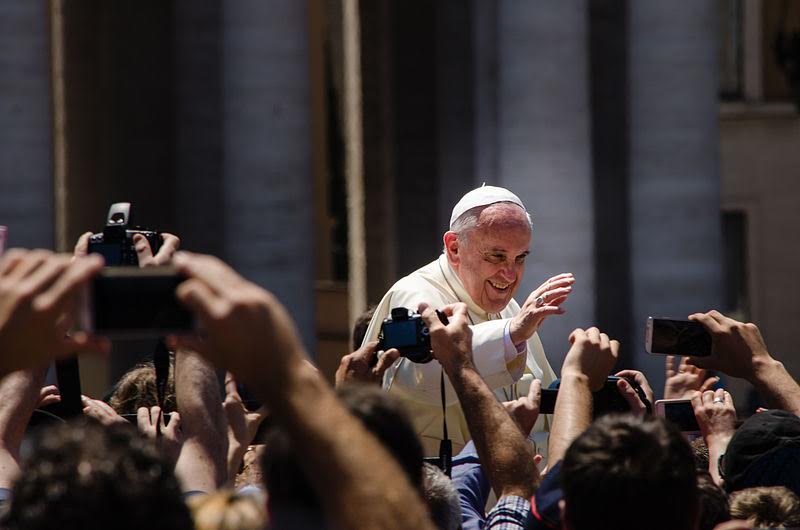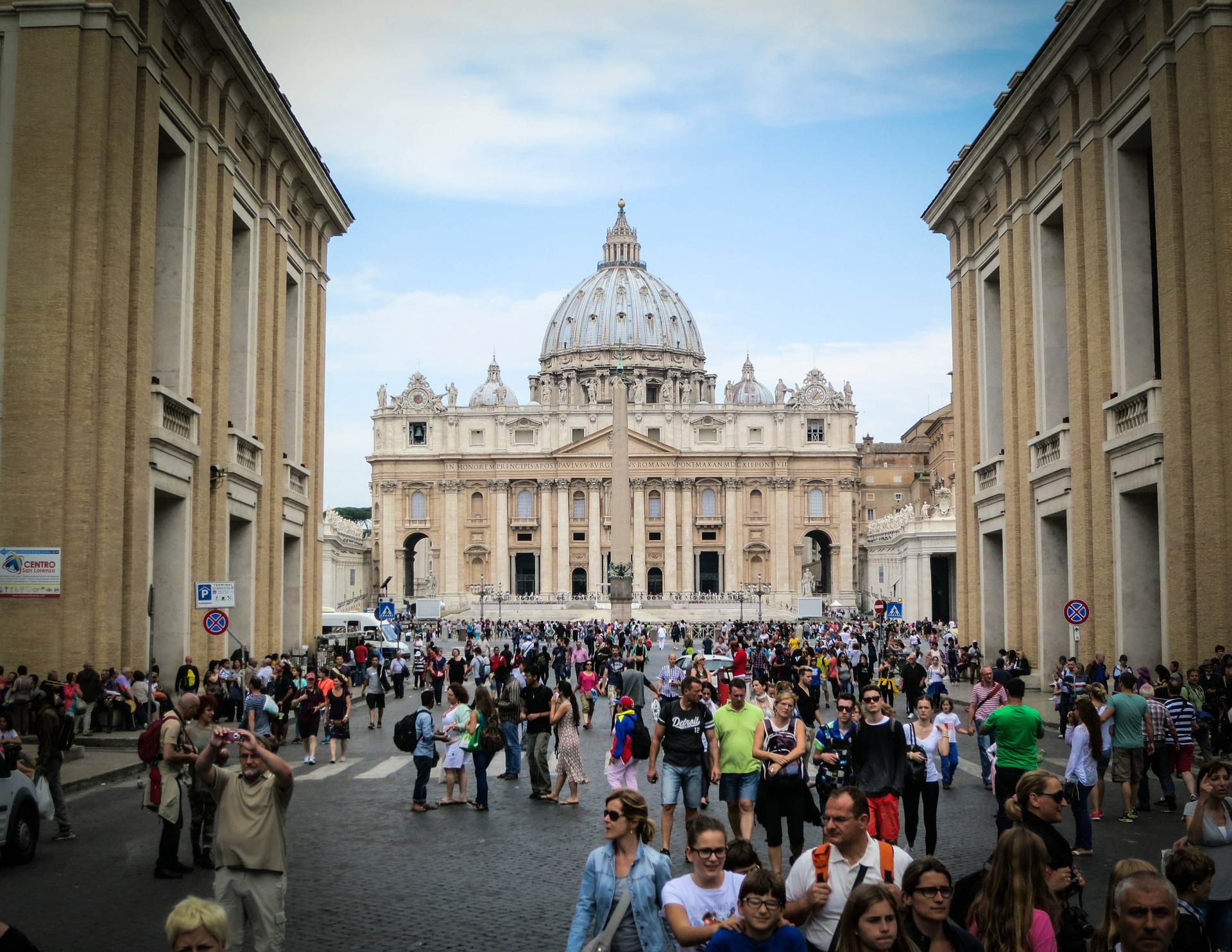Mass attendance is in free fall. A third of those who do attend are age 60 or older. Vocations are shrinking.
As if all that were not enough for the Catholic Church in Australia during the holy season of Lent, Cardinal George Pell was pilloried in March before a Royal Commission investigating child sexual abuse.
Time and time again Pell said it wasn’t his job to act against abusers, it was someone else’s; or he might have done something, but no explicit request was made so he did nothing.
The senior counsel for the commission called his evidence “completely implausible”, the chairman asked a series of embarrassing questions, and the secular media was scathing.
So why, in the outer Melbourne suburb of Keysborough, in a brand new church almost full for the 11 a.m. Mass, does parishioner Coco Stone say: “At last, we can now feel confident, we have hope to keep going Jesus’ way”?
 The short answer is the Pope Francis effect.
The short answer is the Pope Francis effect.
Many Australian Catholics, as have others within the 1.2 billion-member global church, are finding encouragement, renewed optimism and a new energy from the impact and ministry of Francis, who just marked his third anniversary as pope.
From his first public moment, when he stood on the balcony of St Peter’s in Rome and asked the half-million people crowded into the square below to pray for him, the change in tone was palpable. He immediately set out to place a priority on pastoral care, modelling humility and openness.
After his election he rejected a limousine, instead sharing a bus back to his lodgings with other cardinals. He checked out of his hotel himself, paying his own bill and carrying his own bags, and moved into a modest Vatican apartment rather than the papal rooms.
In becoming the first pope in 1000 years to take an unused papal name – itself implying new directions – the choice of Francis was significant: The message was humility, sympathy with creation, and a concern for rebuilding the church.
He conveyed a sense of generosity and inclusiveness. The effect on the church, and the watching world, was instant and dramatic. And he has not faltered since, with an almost unerring ability to strike the right note and deliver powerful, genuine symbols.
It is an appeal that extends beyond Catholics.
Eighty-four percent of Europeans and more than seven in ten Latin Americans viewed him favourably in a 2014 Pew Research Center poll of 43 nations.
In a 2015 poll taken around his second anniversary, seven in ten U.S. adults, including two-thirds of people with no religious affiliation, held Francis in high regard.
No one person can move the needle quickly in terms of numbers or policies in a 1.2 billion member church.
But the pope’s first three years have represented a refreshing start for Catholics like Kath Dowling, 45, a travel consultant who has been part of the Resurrection Parish in Keysborough-Noble Park parish all her life.
Where she works, people never spoke about their faith. But now Catholics and non-Catholics alike are having these conversations, she said, because the pope is in the news.
“It’s like he’s created a safety net,” she said. “He’s made it OK to talk about your faith again.”
Growth and decline
The Catholic Church has experienced steady growth since 1970, increasing from 654 million in 1970 to 1.23 billion today.
Much of the growth is coming from Africa, Latin America and Asia, but Western countries such as the United States also report substantial increases.
Still, the signs of decline, particularly in the West, are noticeable in many countries in decreased Mass attendance and fewer signs of commitment in areas from infant baptisms to getting married in the church.
The global church faces significant challenges everywhere, from a growing global Pentecostal movement that is making strong inroads in Latin America and Africa to persecution in areas from China to the Middle East to rising numbers of young people claiming no religious affiliation.
For some countries, like Australia and Ireland, where the fresh pain of revelations of church complicity in covering up the sexual abuse of children has caused a great loss of public confidence, this is a particularly low point in their history.
Hope amid strife
In Australia, the last national attendance count, in 2011, showed that the number of people at Mass on a typical weekend was about 662,000, or 12.2 per cent of the Catholic population, according to the 2011 Australian Census. This was down nearly 50,000 from the 2006 attendance count.
The median age of Mass attenders also rose slightly to 59.3 years, well above the median age of 45.8 years for the overall Catholic population. Among young Catholics aged 20 to 34, only 6 per cent were at Mass on a typical Sunday.
The reasons for fewer people in the pews are numerous, said Bob Dixon, director of the Pastoral Research Office for the Catholic Church in Australia.
They include difficulties with particular Catholic teachings, disillusionment over sexual abuse issues, lacklustre liturgical experiences, a belief that weekly Mass attendance is no longer obligatory and changes in attitudes to working hours and Sunday sport.
Still, the church continues to grow. The number of Catholics increased 6 percent to 5.4 million people from 2006 to 2011. It is the country’s largest religious group, representing about a quarter of the population. More than half of Catholic students attend Catholic schools.
Immigration is also making it more ethnically diverse. Eighteen percent of Australian Catholics were born in non-English speaking countries. It is probable, according to Dixon, that the 2016 Census will show the Philippines will become the nation supplying the most Catholics to Australia.
But what is tipping the pendulum back toward hope for many Australian Catholics is Pope Francis.
The humble presence of the first non-European pope in nearly 1,300 years is bringing a new spirit of compassion into the church.
At the Keysborough parish, the Rev. Brian Collins never used to quote Pope Benedict in his homilies.
But he uses Francis all the time, he said.
“He’s lifted morale”, Collins said. “The church has been going through a really dark time with the Royal Commission, but people are happy to be Catholic again, and that’s a major shift. He really is about encountering people, like Jesus. Francis is relational – he’s dealing with the hard stuff.”
… here is someone who is one of us, who is like us, he is not standing off.
The hard stuff includes the environment, where his landmark encyclical Laudato Si' calls on the world to engage in a new dialogue about how we are shaping the future of our planet.
Amid a growing international refugee crisis, Pope Francis has been a consistent voice encouraging nations to welcome migrants, at one point calling on every parish and religious community in Europe to each take in one family. This past Holy Thursday, the pope washed and kissed the feet of Muslim, Orthodox, Hindu and Catholic refugees.
Such acts resonate in the pews.
The fact that he comes from a country far from Rome, his love of the poor and his engagement with the disenfranchised are among the many reasons Pope Francis has caught the hearts of Australians, according to Melbourne Archbishop Denis Hart, president of the Australian Catholic Bishops Conference.
“I think some of the most beautiful images I’ve seen, which have captivated Australians, have been the embracing of that poor man with all the growths, or reaching out to people in wheelchairs, his ability as a simple, direct communicator with his own simplicity of life, and the way he spoke about priests, bishops and pope all being sinners.
“His determination to keep the simplicity that we have in our normal lives has endeared him to people because they feel here is someone who is one of us, who is like us, he is not standing off. We can relate the pope’s life to our lives.”
In suburban Sydney, conservative Catholic blogger Monica Doumit says Francis is having a real impact in the lives of Catholics.
 “People are really taking to heart his words about encounter and reaching out,” Doumit says. “I just got a call from a friend on the way to work who helped a woman with a walking-frame. She said, ‘I was on the bus reading the pope’s comments on the globalisation of indifference, and I saw this woman, and I thought this is the moment for me to challenge the indifference.’”
“People are really taking to heart his words about encounter and reaching out,” Doumit says. “I just got a call from a friend on the way to work who helped a woman with a walking-frame. She said, ‘I was on the bus reading the pope’s comments on the globalisation of indifference, and I saw this woman, and I thought this is the moment for me to challenge the indifference.’”
So many stories. So much hope.
“Another friend told her that reading his encyclical on the environment made her feel she should be a vegetarian,” Doumit reported. “Another person said ‘I haven’t been to church in four years but because of Pope Francis I’m interested in having another look.’”
An uncertain future
So has Francis led to a resurgence in Mass attendance in Australia?
That is impossible to measure, Dixon said, because there is no hard data. He suspects the five-yearly Mass attendance count, due in May, will show a continued decline, but it may have been lessened by the Francis effect.
It is also too early to quantify the Pope Francis effect around the world.
No pope, or any public figure, can stand forever atop the popularity ratings.
Expectations raised unrealistically high on issues such as reform of the Curia or divorced and remarried Catholics being allowed to receive Communion without first receiving an annulment can lead to disappointment.
The pontiff can welcome gays and promise accountability for those who cover up or commit crimes of sexual abuse against minors, but such overtures will only have meaning if they are implemented by church leaders throughout the world, said sociologist Fortunato Mallimaci of the University of Buenos Aires, a leading authority on religion and politics in Latin America.
Although he has hugely impressed many non-Catholics and the secular media, those inside the church can be harder to satisfy. Some conservatives fear Francis is too open to change, and some progressives complain he is not moving fast enough.
Doumit agrees some conservative Catholics are troubled.
But she suggested that it is the pope’s informality that sometimes requires the Vatican to hose down over-enthusiastic expectations about potential changes in church doctrine.
Yet if it is not a doctrinal revolution, some who know Francis well said the pope’s genuine faith and his agenda of reform and renewal that places pastoral concerns over judgmental attitudes is part of “a cultural revolution” in the church.
“He’s trying to make church a positive thing,” said Sergio Rubin, religion writer for the Argentinian newspaper Clarin and the co-author of “El Papa Francisco”. “The church is also about love, the afterlife.”
And those are the types of changes that are being embraced by many Catholics around the world, including Resurrection Parish in Keysborough.
“We wanted that Francis effect,” said parishioner Kath Dowling. “We wanted that change, we wanted the spirit to come in and breathe new life into the Church.”
This article first appeared on the International Association of Religion Journalists website.
Barney Zwartz is Senior Fellow at the Centre for Public Christianity and former religion editor for The Age.